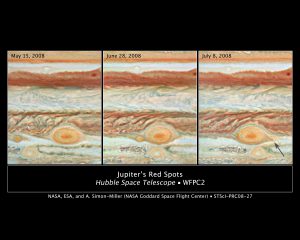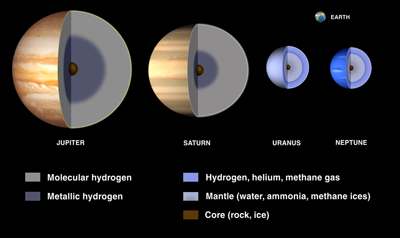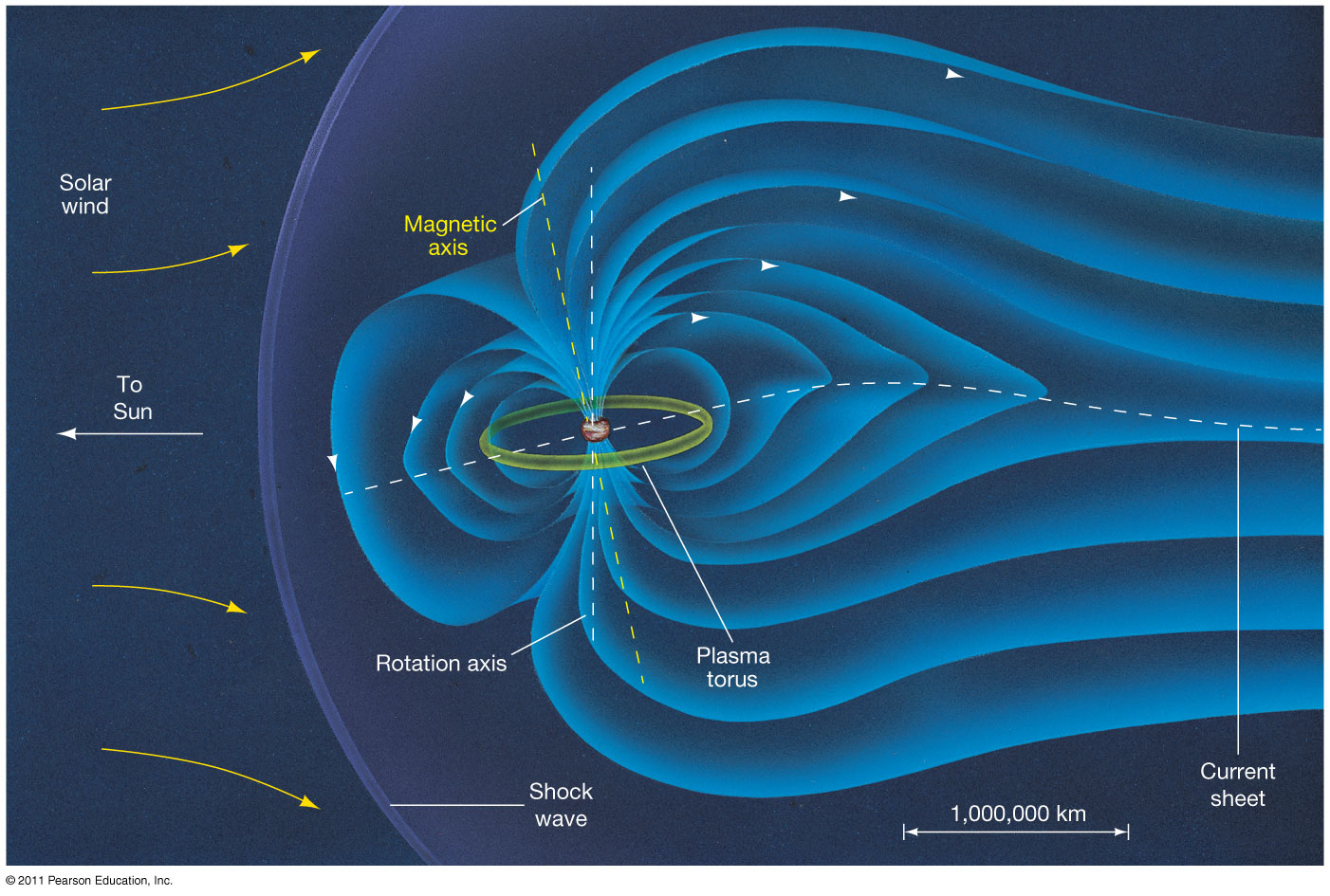Jupiter: An In-Depth Analysis and Comparison to the Sun
Introduction
Although the composition of Jupiter is similar to that of our Sun, it failed to ignite in nuclear fusion. A nuclear fusion reaction similar to that of the Sun requires extreme gravity to compress the hydrogen down to a point where the extreme pressure and temperature pack the hydrogen atoms into helium, which is the energy source for the sun and most stars. ¹ This is also what makes the Sun burn bright. Despite the fact that Jupiter is made of vast  quantities of hydrogen, it is not nearly enough to ignite the planet in nuclear fusion. The minimum amount of mass required for an object to ignite in true nuclear fusion is 80 times that of Jupiter, which is considered to be a red dwarf star.¹ Astronomers draw the line between a brown dwarf, a planet, and a star depending on a variety of factors such as the ignition of nuclear fusion. Although there is a distinction made between Jupiter, brown dwarfs, and stars, one can conclude that there is a definite connection between the planet Jupiter and all stars. This realization begs a variety of questions: Can Jupiter be classified as a star, or as a brown dwarf? Could Jupiter become a star? Could nuclear fusion on Jupiter be triggered, and if so what would happen to our Solar System? This web page will answer these research questions as well as highlight how Jupiter is very similar in composition and structure when compared to a star such as the Sun. We will also explore how Jupiter is ultimately and inherently different from the Sun and all other stars due to its size, orbit, magnetic field, and rotation.
quantities of hydrogen, it is not nearly enough to ignite the planet in nuclear fusion. The minimum amount of mass required for an object to ignite in true nuclear fusion is 80 times that of Jupiter, which is considered to be a red dwarf star.¹ Astronomers draw the line between a brown dwarf, a planet, and a star depending on a variety of factors such as the ignition of nuclear fusion. Although there is a distinction made between Jupiter, brown dwarfs, and stars, one can conclude that there is a definite connection between the planet Jupiter and all stars. This realization begs a variety of questions: Can Jupiter be classified as a star, or as a brown dwarf? Could Jupiter become a star? Could nuclear fusion on Jupiter be triggered, and if so what would happen to our Solar System? This web page will answer these research questions as well as highlight how Jupiter is very similar in composition and structure when compared to a star such as the Sun. We will also explore how Jupiter is ultimately and inherently different from the Sun and all other stars due to its size, orbit, magnetic field, and rotation.
Figure 1: Jupiter: the giant gas planet (http://abyss.uoregon.edu/%7Ejs/images/Jupiter.gif
Hot Spot
When comparing the heat of Jupiter to the heat of a star there is a huge difference. A star can reach up to about 100,000 F, whereas Jupiter reaches up to ~2300 F within the core, although the outer edges of the planet can get down to -145 Celsius.2 The Earth is closest to the Sun yet much cooler than Jupiter, how is this possible?
Even though Jupiter’s heat is miniscule compared to that of a star it still has an intense heat compared to the other planets.³ As mentioned earlier, Jupite r is farther from the Sun, so there must be an alternate heat source.
r is farther from the Sun, so there must be an alternate heat source.
Through research they have discovered a mechanism for this alternative heat, the hot spot. Jupiter’s hot spot is centered over the famous Great Red Spot. Within this area, there are gigantic storms spanning larger than the diameter of Earth. Since Jupiter has such an intense temperature gradient (core vs. outer edges), the cool and warm air will mix together to generate storms.2 The crashing storms produce acoustic waves and some gravity waves. Acoustic waves are created by the speed of sound, whereas gravitational waves are ripples in spacetime.⁴ The gravitational waves are quite weak, therefore the acoustic waves are the main source of heat.⁴ They cause the collision of the gas molecules, raising the temperature within the spot.⁵ This temperature is measured by the NASA Infrared Telescope Facility (IRTF) located on Mauna Kea in Hawaii.⁵
Even with Jupiter’s intense heat, it is still not hot enough to trigger a nuclear reaction. The conditions necessary for nuclear fusion are simply not probable in Jupiter. The temperature gradient follows the molecular gradient, so if the composition of Jupiter were to change drastically, the temperature would most likely follow.¹ Therefore, standing alone, temperature is not enough for Jupiter to ignite into a star; other actions must happen, such as more mass colliding into the planet.⁶ There is much on-going information and research within this topic.
Figure 2: Jupiter’s hot spot as seen from the Hubble telescope (https://commons.wikimedia.org/wiki/File:Three_Red_Spots_Mix_It_Up_on_Jupiter.jpg)
Composition
Jupiter has a similar composition as the Sun, being mainly composed of helium and an ionized state of hydrogen (H3+) that emits infrared light.⁴ The atmosphere is composed of 90% hydrogen and almost 10% helium, with a few traces of ammonia, sulfur, methane and water vapour. 7 These measurements are known to us because of the spectra recordings by the Near Infrared Mapping Spectrometer (NIMS) instrument on the Galileo spacecraft in 1996.8 Since Jupiter is a gas giant, the composition of the atmosphere is essentially the composition of the entire planet, making it very similar to the Sun in that regard. Furthermore, a quadrupole mass spectrometer on the Galileo probe determined that even these mixing ratios of helium to hydrogen of Jupiter’s atmosphere are close to that of the Solar ratio.⁹ Simply put, a spectrometer works by measuring the absorbed light of certain elements on the atmosphere, which generates a light signature. This light signature tells scientists exactly what elements are present in the atmosphere by comparing it to light signature of the known elements.10
As you travel further inwards towards the center of Jupiter the temperature and pressure increases, which compresses the hydrogen gas into a liquid, creating a massive ocean.¹¹ Still further down lies Jupiter’s core, the composition and state of which remains unknown. It is believed that the core could be one solid mass or a very dense, very hot, thick soup, mostly made of iron and silicate minerals.12
 There is no doubt that, in regards to composition, Jupiter is very similar to our Sun. Why is it that Jupiter never ignited in nuclear fusion, but the Sun did? Simply put, Jupiter would require much more mass to ignite like a star. To become a star, it’s just simply not enough to have the right materials, you’d also require enough of those materials, much more than that of Jupiter. In order for a star to be born, nuclear fusion reactions must occur, which require extreme gravity to provide high enough pressures and temperatures to cram hydrogen atoms into helium. This type of reaction would also require vast quantities of hydrogen, a minimum of 80 times the hydrogen that is available on Jupiter to ignite in true nuclear fusion. Which is considered the red dwarf star, the smallest of the true stars.1
There is no doubt that, in regards to composition, Jupiter is very similar to our Sun. Why is it that Jupiter never ignited in nuclear fusion, but the Sun did? Simply put, Jupiter would require much more mass to ignite like a star. To become a star, it’s just simply not enough to have the right materials, you’d also require enough of those materials, much more than that of Jupiter. In order for a star to be born, nuclear fusion reactions must occur, which require extreme gravity to provide high enough pressures and temperatures to cram hydrogen atoms into helium. This type of reaction would also require vast quantities of hydrogen, a minimum of 80 times the hydrogen that is available on Jupiter to ignite in true nuclear fusion. Which is considered the red dwarf star, the smallest of the true stars.1
Jupiter may be much too small to be classified as a true star, but can it be more easily compared to a brown dwarf star? A brown dwarf star is an object that is similar in composition to a star, but too small to hold true nuclear fusion.⁷ Instead, brown dwarf stars can ignite a limited form of fusion. This type of fusion is relatively short term compared to that of a star, and is done by fusing a heavy isotope of hydrogen, known as deuterium (2H), into helium. However, even the minimum amount of mass required to fuse deuterium and to be classified as a brown dwarf star is still 13 times that of Jupiter.1
Jupiter may have similar composition to that of the Sun and the stars, but it only contains a small fraction of the mass required for it to be classified as a star or even a brown dwarf. Neither nuclear fusion or the fusing of deuterium can be triggered with the relatively low mass of Jupiter, leaving it as just another planet in our solar system.
Figure 3: Composition of Jupiter (http://astronomyonline.org/SolarSystem/Images/GasGiantInteriors_th.jpg)
Rotation/Spin
Jupiter is unlike any other planet. Due to the fact that its composition is mainly hydrogen with a sprinkling of rock and ice, astronomers find it difficult to pinpoint how the planet spins. What is known is that it is the fastest spinning planet in the Solar System. The rotation is so fast that it causes Jupiter to bulge at its equator, giving it an appearance of a squashed basketball. ¹³

The squashing of Jupiter means that the different sections of Jupiter spin at different distances and at different speeds. The bulge at the polar radius measures a modest 66,800 km while the equator measures in at almost 72,000 km.¹⁴ This means that a full rotation period depends upon the spot on Jupiter. The rotation of the poles, for example, takes 5 minutes longer to complete than rotation at the equator. Astronomers generally take an average of the two locations, producing an average full rotation time of 9.9 earth hours. ¹⁴
As already discussed, Jupiter and the Sun have a similar gaseous composition. In comparison, the Sun also does not rotate as one cohesive unit. Much like Jupiter, the poles of the Sun rotate at a much slower rate than the equator. The radioactive core of the Sun also rotates in one solid form separate from its outer portion.¹⁵ That is as similar as the two get, however, as the Sun rotates counterclockwise and at a much slower speed than Jupiter. Using a point of approximately 26 degrees from the Sun’s equator, the point where we can see the most sunspots, astronomers have been able to determine how long it takes for the Sun to make a complete rotation. At 26 degrees, it takes approximately 25 days for the Sun to rotate and return to the same spot in space.¹³
Figure 4: rotation of jupiter with its moon Io (http://astronomy.robpettengill.org/blog170512.html)
Rings
Four of the planets in the Solar System have rings: Jupiter, Saturn, Uranus, and Neptune. It was not until the 1970s that Jupiter’s rings were discovered, when NASA’s Voyager 1 spacecraft flew closeby.¹⁶ It has a system of rings known as the “Rings of Jupiter” or the “Jovian Ring System.” This ring system is faint, dark, and narrow, mainly composed of tiny rock fragments and dust. The rings are not very bright because they do not reflect very much of the sunlight that they receive. The ring system can be broken down into three sections: Main, Halo and Gossamer.¹⁷
- The Main Ring is bright and thin. It spans 6400 km wide and less than 30 km thick. It starts at 122,800 km from the center of Jupiter and has an outer edge 129,130 from the center of Jupiter. Two small moons, Adrastea and Metis, orbit within the Main ring, and it is thought that they may be the source of dust debris. ¹⁷
- The Halo Ring is a thick inner torus of particles, the shape of a doughnut. It is about 22,800 km wide and about 20,000 km thick. This ring starts at 100,000 km from the center of Jupiter; and then the outer edge of the Halo merges into the Main ring.¹⁷
- The Gossamer Ring is a very faint and wide and composed of very tiny particles. It consists of two rings, one embedded within the other. This ring starts at 129,000 km from the center of Jupiter, and extends beyond the orbit of the moon Amalthea.¹⁷
Magnetic Field

Figure 5: Jupiter’s magnetic field (https://desayunoconfotones.org/2015/03/09/tim-bowers-radiofisico-espacial-parte-2/ )
Jupiter has a very powerful magnetic field, caused by the large ocean of liquid metallic hydrogen. Hydrogen is usually a gas, but on Jupiter hydrogen became a liquid due to the great pressure.¹⁸ As the planet spins, the ocean creates the strongest magnetic field in the solar system, 20,000 times that of the Earth.¹⁸ The magnetic field of a star is half that of Jupiter’s magnetic field, being 10,000 times that of the Earth. ¹⁹ The magnetic field in a star is so far below the exterior it was believed at one point that only some stars had a magnetic field. ¹⁹ Even though stars have a smaller magnetic field, sunspots are formed because of them. Because of the intense force of its magnetic field, therefore, Jupiter could not have become a star.¹⁹
Conclusion
It is evident that the planet of Jupiter is ultimately and inherently not a star or a dwarf star. There are differences in rotation, orbit, rings, magnetic field, and temperature that make the two divisions extremely different, which has lead us to the conclusion that Jupiter will never be classified as a star or dwarf star. Although there is a definite connection between the planet Jupiter and stars, because of the dense and gaseous state Jupiter lives in, Jupiter just does not contain the right amount of mass to be a star or a dwarf star. Could the planet ever become a star? Possibly with a massive astronomical reaction which would require a huge amount of energy and mass, but it is very unlikely this will occur.20 Even if nuclear fusion was triggered on Jupiter, it would have very little impact on our Solar System and life on Earth. At its closest to Earth, Jupiter is still 4 times further away from us than the Sun is, so if Jupiter were to become a small star it would probably have little to no impact on Earth’s life. Jupiter would have to become 100 times more massive, 20% bigger, and .3% as bright as the Sun in order to be a star. 20 To those on Earth, this Jupiter star would be 80 times brighter than a full moon at its brightest, so it would be clearly visible every day and night. Additionally, the star would be very distinctively red in color being that it would be much colder than the Sun.21
Through our research we have concluded that Jupiter can be considered a “failed” star because it has the same components as the Sun. Much like Jupiter and its hot spot, the sun rotates in layers.⁹ They are also both made up of similar gases such as hydrogen and helium. The difference is Jupiter is like the other gas planets and is composed of ice/rock and gases. This means that Jupiter lacks the internal pressure and temperature needed to get enough helium, the energy source of the sun and most stars.
We have investigated reliable sources on the Internet, as well as academic papers, books, and the online library resource from The University of Saskatchewan.
References
- Cain, Phys.org – Could Jupiter become a star? (2014). https://phys.org/news/2014-02-jupiter-star.html
- O’Donoghue, Nasa.gov (2016). www.nasa.gov
- Universe Today (2015).
- Institute of Physics Publishing, Physics.org (2016). physics.org
- Drake. Nationalgeographic.com, (2016). www.nationalgeographic.com
- Young, R. Yelle, R. Young, A. Seiff. Science. 276. 5309 (1997)
- T. Redd, Space.com https://www.space.com/24467-brown-dwarfs-failed-stars-explained-infographic.html (2012)
- G. J. Irwin, A. L. Weir, S. E. Smith, F. W. Taylor, A. L. Lambert, S. B. Calcutt, P. J. Cameron-Smith, R. W. Carlson, K. Baines, G. S. Orton, P. Drossart, T. Encrenaz, M. Roos-Serote. Journal of Geophysical Research. 103. 23001 (1998)
- Niemann, S. K. Atreya, G. R. Carignan, T. M. Donahue, J. A. Haberman, D. N. Harpold, R. E. Hartle, D. M. Hunten, W. T. Kasprzak, P. R. Mahaffy, T. C. Owen, N. W. Spencer, S. H. Way. Science. 272. 5263 (1996)
- Staughton, Science ABC https://www.scienceabc.com/nature/universe/scientists-determine-atmosphere-planets.html (2017)
- Dunford, NASA solar system exploration https://solarsystem.nasa.gov/planets/jupiter/indepth (2017)
- Wethington, Universe Today https://www.universetoday.com/14469/jupiter/ (2008)
- Cain Rotation of Jupiter. https://www.universetoday.com/author/admin/ (2017)
- Lang, The Cambridge guide to the solar system (Cambridge University Press, Cambridge, 2011).
- Cain. Does the Sun Rotate. https://www.universetoday.com/60192/does-the-sun-rotate/ (2015)
- Jupiter -Rings, Planets – NASA Solar System Exploration. https://solarsystem.nasa.gov/planets/jupiter/rings
- Enchanted Learning, (1999-2016), http://www.enchantedlearning.com/subjects/astronomy/planets/jupiter/jupiterrings
- Flint Wild, What is Jupiter (2016)
- California Institute of Technology, Strong Magnetic Fields (2016)
- Kraus, Is Jupiter a Failed Star? (2015)
- Godfrey, Gas Giant Planets, Small Failed Stars: Is There a Difference? (2016)